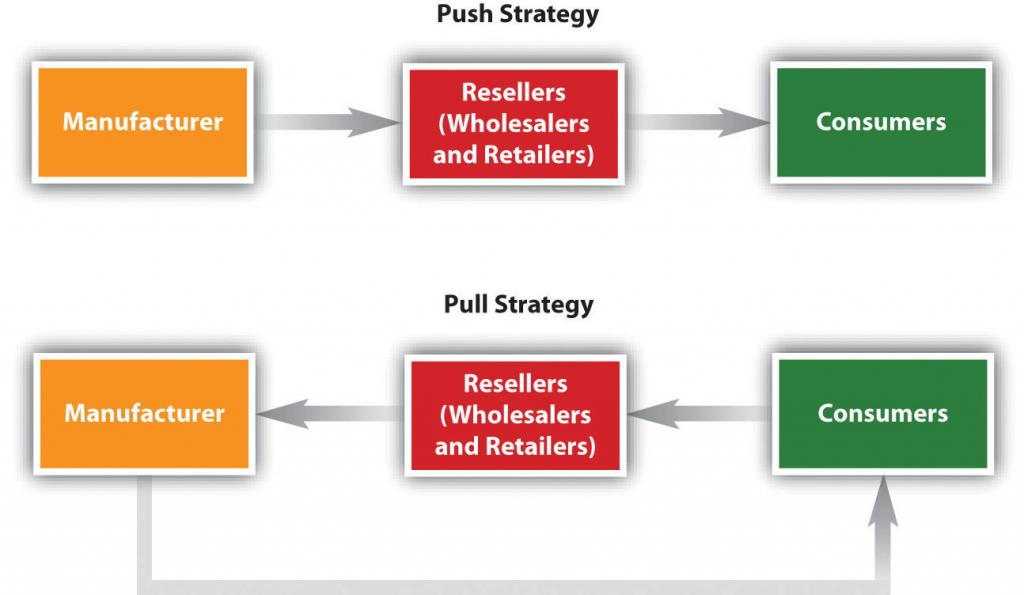8.3: Functions Performed by Channel Partners
- Page ID
- 5010
Learning Objectives
- Describe the activities performed in channels.
- Explain which organizations perform which functions.
Different organizations in a marketing channel are responsible for different value-adding activities. The following are some of the most common functions channel members perform. However, keep in mind that “who does what” can vary, depending on what the channel members actually agree to in their contracts with one another.
Disseminate Marketing Communications and Promote Brands
Somehow wholesalers, distributors, retailers, and consumers need to be informed—via marketing communications—that an offering exists and that there’s a good reason to buy it. Sometimes, a push strategy is used to help marketing channels accomplish this. A push strategy is one in which a manufacturer convinces wholesalers, distributors, or retailers to sell its products. Consumers are informed via advertising and other promotions that the product is available for sale, but the main focus is to sell to intermediaries.
Figure 8.12 A Push versus a Pull Strategy

The problem with a push strategy is that it doesn’t focus on the needs of the actual users of the products. Coca-Cola used a push strategy for years before realizing that instead of focusing on moving beverages through a retailer’s back door and into their warehouse, it needed to help them sell to shoppers through the retailer’s front door1. College textbook publishers are in a similar position today. Traditionally, they have concentrated their selling efforts on professors and bookstore managers. (Has a textbook company ever asked you what you want out of a textbook?) It’s no secret that the price of textbooks is climbing and students are purchasing fewer of them. Like Coca-Cola, textbook publishers are probably going to have to rethink their sales and marketing channel strategies (Blumenstyk, 2009).
Figure 8.13

Entrepreneurs Jeff Shelstad (pictured) and Eric Frank (not pictured) launched the publisher of this textbook. Shelstad and Frank believe they have found a way to add more value to the textbooks you buy. One of their strategies is to deliver their products via a marketing channel that’s different from those used to sell traditional textbooks.
By contrast, a pull strategy focuses on creating demand for a product among consumers so that businesses agree to sell the product. A good example of an industry that utilizes both pull and push strategies is the pharmaceutical industry. Pharmaceutical companies promote their drugs to pharmacies and doctors, but they now also run ads designed to persuade individual consumers to ask their physicians about drugs that might benefit them.
In many cases, two or more organizations in a channel jointly promote a product to retailers, purchasing agents, and consumers and work out which organization is responsible for what type of communication to whom. For example, the ads from Target, Walmart, and other retailers you see in the paper on Sunday are often a joint effort between manufacturers and the retailer. Coupons are another joint form of promotion even when offered directly by the manufacturer, joint in the sense that the retailer still has to accept the coupon and process it. The actual forms and styles of communication will be discussed more in the promotions and sales section of the book.
Sorting and Regrouping Products
As we explained, many businesses don’t want to receive huge quantities of a product. One of the functions of wholesalers and distributors is to break down large quantities of products into smaller units and provide an assortment of different products to businesses.
For example, cranberry farmers have large crops to sell. You don’t want to buy large amounts of cranberries, make your own juice or cranberry sauce, or dry them into craisins for salads. So the farmers sell their produce to a coop, which sorts the berries by size; large ones become craisins while others are destined to become either juice or sauce, depending on their liquid content. Those are then sold to the juice and sauce producers.
Storing and Managing Inventory
If a channel member has run out of a product when a customer wants to buy it, the result is often a lost sale. That’s why most channel members stock, or “carry,” reserve inventory. However, storing products is not free. Warehouses cost money to build or rent and heat and cool; employees have to be paid to stock shelves, pick products, ship them, and so forth. Some companies, including Walmart, put their suppliers in charge of their inventory. The suppliers have access to Walmart’s inventory levels and ship products when and where the retailer’s stores need them.
Storing and managing inventory is not just a function provided for retailers, though. Storage also involves storing commodities like grain prior to processing. Gigantic grain elevators store corn, wheat, and other grains until processors, like Oroweat, need them. You can buy fresh bread in your grocer every day because the wheat was stored first at a grain elevator until it was needed.
Video Clip
Warehouse Robots at Work
(click to see video)
Not all warehouses utilize humans to pluck products from shelves. Some of them use robots, as this video shows. Robots cost money, too, though.

